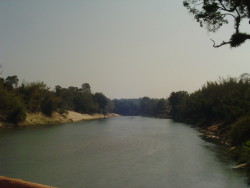
He looked like he was in his early 30’s, the perfect age for a prenatal victim of Agent Orange, which the U.S. government mercilessly sprayed over this part of Laos throughout the Indochina War. The Mechanic looked at me, flashed me a smile, lit a cigarette, and made his way to my bike for an inspection. By the look on his face I could tell that the fix would be no problem, and he was soon barking orders to the gang of bored looking boys who had gathered around us to take in the action. One boy scurried up a ladder and into a hut, reappearing with a burlap bag filled with some tools.
The Mechanic quickly got to work, ripping off the tired and tube, locating the leak, and patching it up. At one point, when his kid helper couldn’t locate the extra tire patching, The Mechanic climbed up the ladder and into the hut, using only his arms and doing so with the confidence of an expert. He came back down with the patch tube and finished the job.
He easily re-railed the chain, even tightening it up a bit with his wrench. When the bike was ready to go I paid him his fee – one dollar – and went on my way.
The next stretch of road was the most isolated and beautiful on the Nakai Plateau. The villages disappeared, and soon I was riding through untouched forests and jungle. The traffic was light, and I made a steady but reasonable pace down the rocky road.
My goal for the day was the town of Lak Sao, the last stop in Lao before the border with Vietnam. Within an hour I was crossing the Nam Hin Bun, which stretched out below me and reflected the noon sun. A new bridge was being built a half of kilometer up, and soon, within a year or two, the river would be dammed (Or should I say “damned?”) and much of what I had seen would be underwater. Ahhhh, progress. The words of Edward Abbey, whose “Desert Solitaire” I had completed just days before, rang in my head:
“Our modern industrial economy takes a mountain covered with trees, lakes, running streams and transforms it into a mountain of junk, garbage, slime pits, and debris.”
Nam Hin Bun.
Crossing the Nam Hin Bun.
Village on the Nakai Plateau.
River near said village.
Soon I came upon two other riders covered in dust. It was Inga and Steve. They too had stayed in Nakai the night before, but they were at a different guesthouse. They were in good spirits and their bikes had held up for them well. They were incredulous when I told them about my troubles.
I rode with the Belgians for a while, but their pokey pace was a bit too slow for my liking, so I gave them a wave and cranked up the throttle.
The road began to wind down from the Nakai Plateau, and now the string of trucks making their way up and down was intolerable. I rode through Saharan dust clouds and was nearly forced off the road by coffee-jacked truck drivers rushing to make their deliveries in time. As I coughed up dirt and picked dust nuggets from my nose, I thought of a clean shower and hot meal awaiting me in Lak Sao. My fantasy was soon interrupted, however, by another flat tire. The Mechanic had just patched the tube. They had no new ones in the village to sell me. The stress of the road was evidently too much for the tire to bear, and the patch failed. So I pushed the bike down the road, soon passed by the Belgians, who could only laugh and look at me with sympathetic eyes.
Soon I was off of the plateau and into a village. This village was the most developed settlement since Nakai. It may have even had electricity. I pulled off at the first mechanic I spotted and he had a new tube on and inflated within ten minutes. This is the terrific thing about breaking down in Laos. Everyone rides 100cc bikes for transportation, so even the most primitive village has someone who can fix them. Let us give thanks to the invention of interchangeable parts.
After stopping for a brief swim in a cool river, I caught up with the Belgians and accompanied them into Lak Sao. Lak Sao is used as a stop over point on the way to and from Vietnam, so despite the rugged frontier feeling to the place, there are plenty of good places to stay. I got a huge room in a guesthouse in the shadow of and imposing mountain. It even had hot water, though the water was only truly hot at the lowest volume – which was nothing more than a trickle – so I spent the greater part of thirty minutes feeling like I was getting peed on.
I took a wander through the town, which is located at a crossroads with a main, paved route. The worst part of the journey appeared to be over. The rest would be on smooth, sealed roads. I wandered through the market, past stalls selling clothes and food. Meat sat out on tables, unrefrigerated, shining in the periodic bursts of sun. One stall featured several gutted rats and what appeared to be a guinea pig. Lak Sao is located in a mountainous and unspoiled part of the country, and much of the local wildlife was evidently available for consumption at this market, but in recent years there has been less and less to eat, as the hunt went on unchecked. Just rats and pets left, it seemed.
I joined Inga and Steve at the main restaurant in town, aptly named “The Only One.” The menu was vast, containing your usual fried rices and curries, along with a dish puzzlingly named:
We ordered the chicken and fish.
Soon a man rolled up on a big dirt bike. It was Don, my map making drinking buddy from the night before. He had been all the way up to the border, which is at a high elevation, and was too chilled to continue with his ride. An unnatural and frigid wind blew down from the mountains that day, making motorbike travel a balls-chilling affair. So he joined us and we ordered more food and more beers, continuing our impromptu party well into the night.
We were eventually joined by three Aussies who rode in on dirt bikes, as well as a group of about 40 elderly Dutch people from a tour bus staying the night on its way to Vietnam. To see a true trailblazer such as Don and this herd of package tourists in the same room truly represented the two extremes of Southeast Asian travel. By the end, aided by countless bottles of beer, I had made friends with them all. And after nearly falling asleep at the table, I said my goodbyes and stumbled back to my room though the pitch black of the town.
Day 3
Cold morning, day 3.
The morning proved to be even more frigid than the night. The wind had intensified and I could see my breath, a phenomenon I hadn’t counted on for this trip to the “tropics.” I put on my pants, two t-shirts, two button-up shirts and my sweater, and proceeded to zip down the road, savoring the smooth surface and quick pace. The dirt track was behind me, and once again I was on smooth and sealed hard surface. Like the two previous days, the ride started out perfectly. I was winding through wide valleys, punctuated by huge mountains. It was dramatic country, reminiscent of scenery found in the American West.
I made it about an hour down the road – which was pretty typical for the trip – before my I hit my first patch of trouble. There was a dip in the road and I was heading back up at a pretty steep grade. I had the bike opened up at a good speed, when the engine suddenly started making a terrible high pitch noise, as if it were wheezing. I lost compression and a lot of power, and then the bike just died. By now I had cleared the top of the hill and just coasted it down, pop starting it near the bottom. The engine fired up, but now it sounded weak and unwell, and I was only getting about half the power I was before. This was accompanied by a thick blue smoke belching out of the tail pipe. I was burning oil.
This article continues in part 5.
Chris Tharp, 26 August 2007
Additional information
Presentation of the author:
Chris Tharp is a former actor, comedian, and playwright from Seattle, Washington. He currently lives in South Korea, where he teaches at Busan Kyungsan College. He spends his spare time writing, fishing, playing music, motorcycling, performing, hiking, drinking, and eating still-moving seafood, though not necessarily in that order. Check out his blog: http://www.livejournal.com/users/tharp42
Information about Laos:
Laos is officially called the Lao People's Democratic Republic. The country is a landlocked communist state in southeast Asia, bordered by Myanmar (Burma) and China to the northwest, Vietnam to the east, Cambodia to the south, and Thailand to the west.
As Lonely Planet describes it on its website (www.LonelyPlanet.com): Snaking rivers, lush jungle, hectic markets and the UNESCO-listed Plain of Jars. Lonely Planet considers Laos as the highlight of Southeast Asia.
Laos traces its history to the Kingdom of Lan Xang or Land of a Million Elephants, which existed from the fourteenth to the eighteenth century. After a period as a French protectorate, it gained independence in 1949. A long civil war ended when the communist Pathet Lao movement came to power in 1975.












